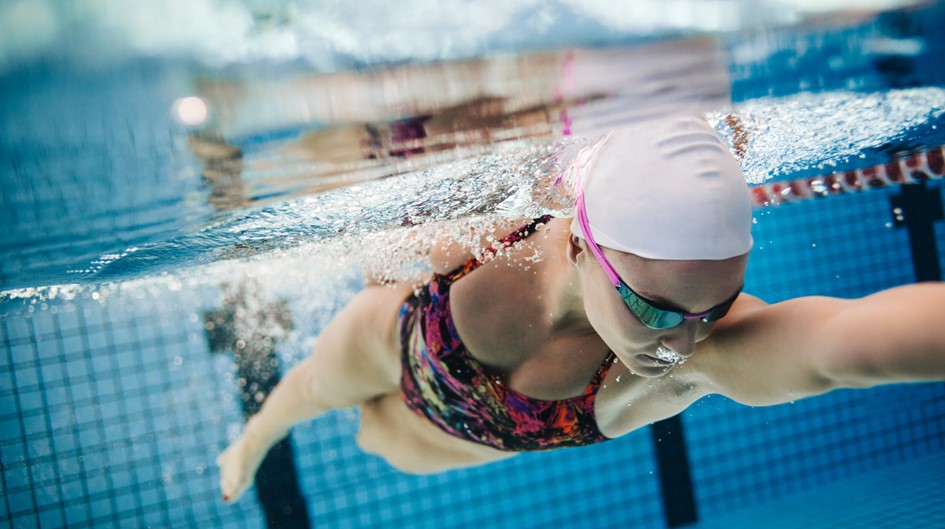|
Breath holding and hypoxic swimming is a training technique that can be performed in a number of ways. It can involve swimming a number of strokes without taking a breath or swimming a whole length of the swimming pool without breathing, or swimming underwater for extended periods of time also without taking a breath. This technique is often used by competitive swimmers and triathletes to improve their endurance and overall performance. However, it is important to note that breath holding and hypoxic swimming can also be dangerous if not done properly. One of the main benefits of breath holding and hypoxic swimming is that it improves a swimmer's lung capacity and endurance. When a swimmer holds their breath and swims underwater or a lap of the pool without breathing, they are forced to use their oxygen more efficiently. This can lead to an increased lung capacity, allowing the swimmer to hold their breath for longer periods of time and swim longer distances. You can also see this technique used in many competitive sprint events. Most international 50 metre sprint specialists will not even take a breath on their one length sprint race. Butterfly swimmers may breathe every 5 or 6 strokes during a race. These elements of a race are often practiced and perfected during their swimming training. During sprint races, swimmers may choose to limit their breathing to reduce drag and maintain their speed. For example, in a freestyle sprint event, a swimmer may take fewer breaths or even hold their breath for short periods to maximize their efficiency and speed through the water. Breath holding can be a useful technique for triathletes during the swim portion of the race. By limiting the frequency of their breaths, triathletes can reduce the amount of time they spend with their head out of the water and maintain their momentum and speed. This can be particularly beneficial in choppy or rough water conditions where it may be more difficult to maintain a consistent breathing pattern. However, it's important for triathletes to practice breath holding in a safe and controlled environment and to avoid pushing themselves beyond their limits to prevent the risks associated with prolonged oxygen deprivation. Please talk to our Strictly Swimming London coaches about adding some hypoxic breath holding work into your lessons. Another benefit of breath holding and hypoxic swimming in your lessons is that it improves a swimmer's mental toughness. Swimming underwater for extended periods of time requires a great deal of mental focus and concentration. This type of training can help swimmers and triathletes develop a stronger mental game, allowing them to perform better under pressure. Additionally, hypoxic training has been shown to improve the body's ability to use oxygen effectively, by triggering the production of additional red blood cells, this can be beneficial for any endurance sports. However, it is important to note that breath holding and hypoxic swimming can also be dangerous if not done properly. One of the main risks associated with this technique is the potential for a shallow water blackout. A shallow water blackout occurs when a swimmer loses consciousness due to a lack of oxygen. This can happen if a swimmer holds their breath for too long or if they push themselves too hard during training. To minimize the risks associated with breath holding and hypoxic swimming, it is important for swimmers and triathletes to always have proper supervision and to never swim alone. It's also important to start with shorter periods of time and gradually increase the duration of breath holding as you improve. Setting realistic goals and not pushing yourself too hard is also crucial. It's also essential to have proper breathing techniques before starting hypoxic training lessons, otherwise the risk of blackout could be higher. Swimmers should also be aware of the signs of hypoxia, such as dizziness, confusion, or nausea, and should stop training immediately if they experience any of these symptoms. Strictly Swimming London coaches will take you though some gradual steps to minimise these risks. In conclusion, breath holding can be a useful training tool for swimmers as it helps to increase their lung capacity, improve their oxygen utilization, and develop their mental toughness. By holding their breath for short periods of time, swimmers can learn to manage their oxygen levels more effectively and become more efficient in the water. Additionally, breath holding can be particularly useful for sprinters as it allows them to maintain their speed and reduce drag by minimizing their head movement. However, it's important for swimmers to approach breath holding with caution and receive proper training to avoid the risks associated with prolonged oxygen deprivation. With proper supervision during your Strictly Swimming London lessons, realistic goals, and a gradual increase in duration, swimmers can safely and effectively use breath holding and hypoxic swimming to improve their performance. |
AUTHORPaul started competing in swimming from the age of 8 and eventually went on to represent his country all over the world. During his time at University, Paul specialised in Aquatics and the Biomechanics of Swimming and produced numerous theses on swimming performance. TOPICS
All
ARCHIVES
June 2024
|
Let's connect!
Copyright © 2024 Strictly Swimming


